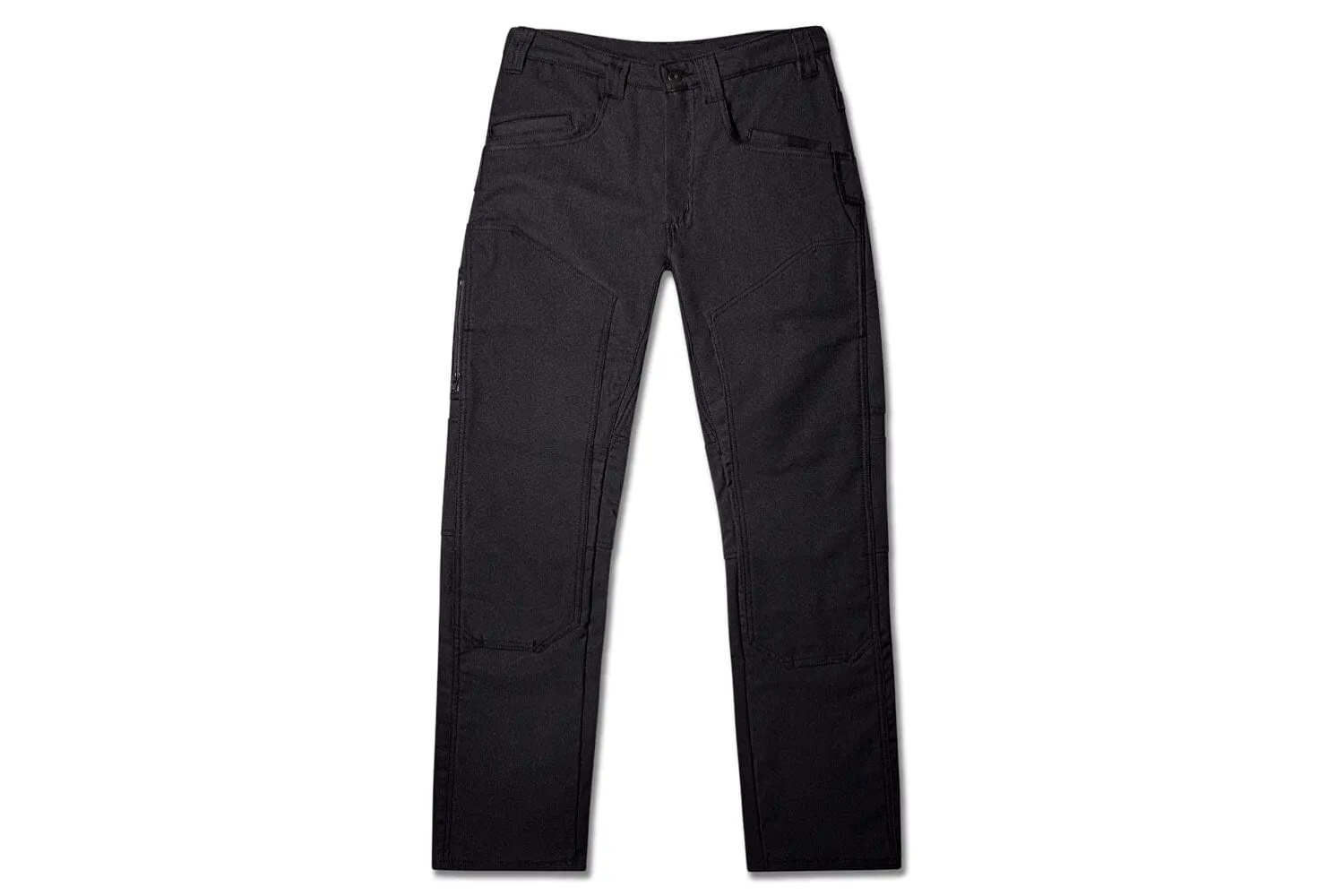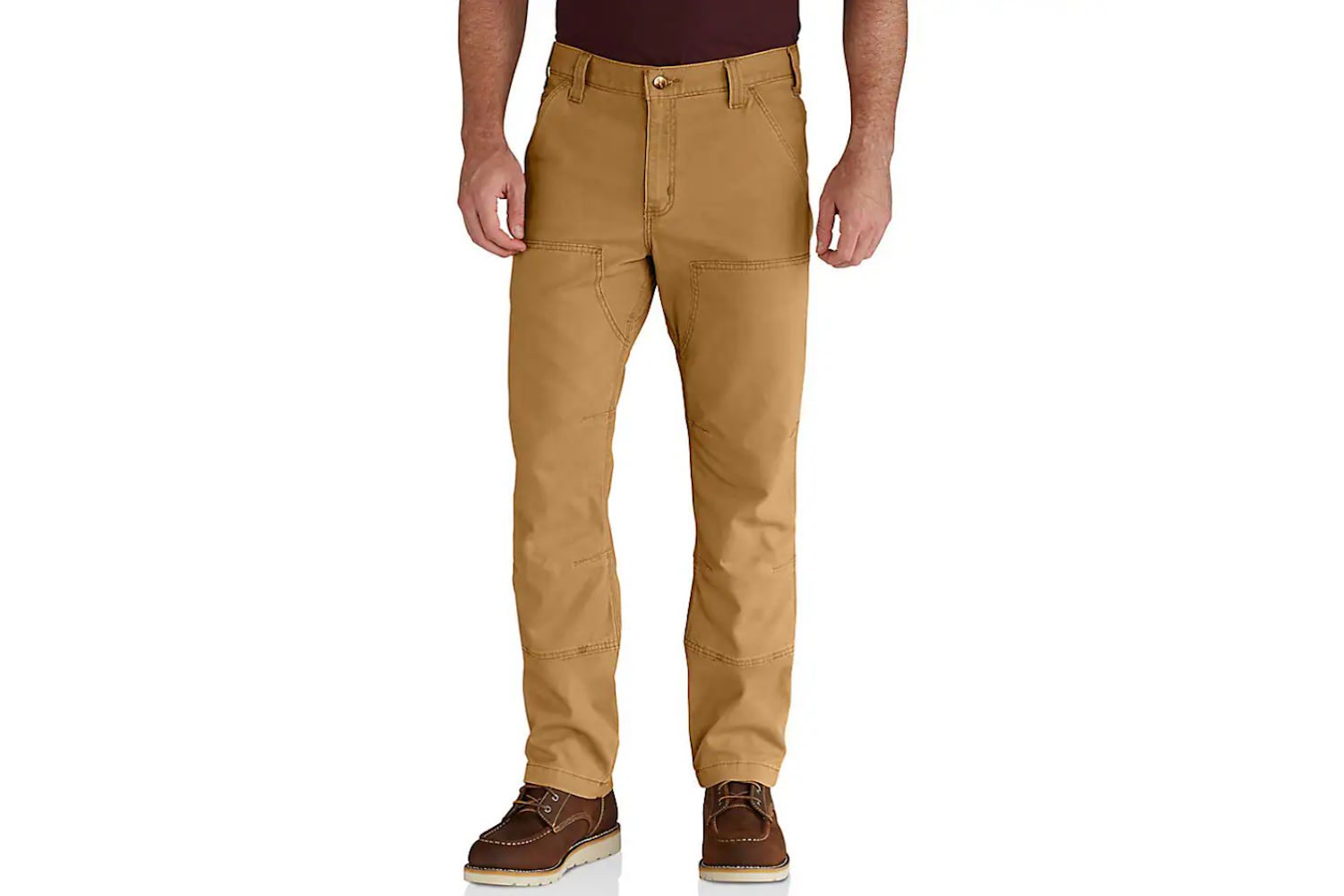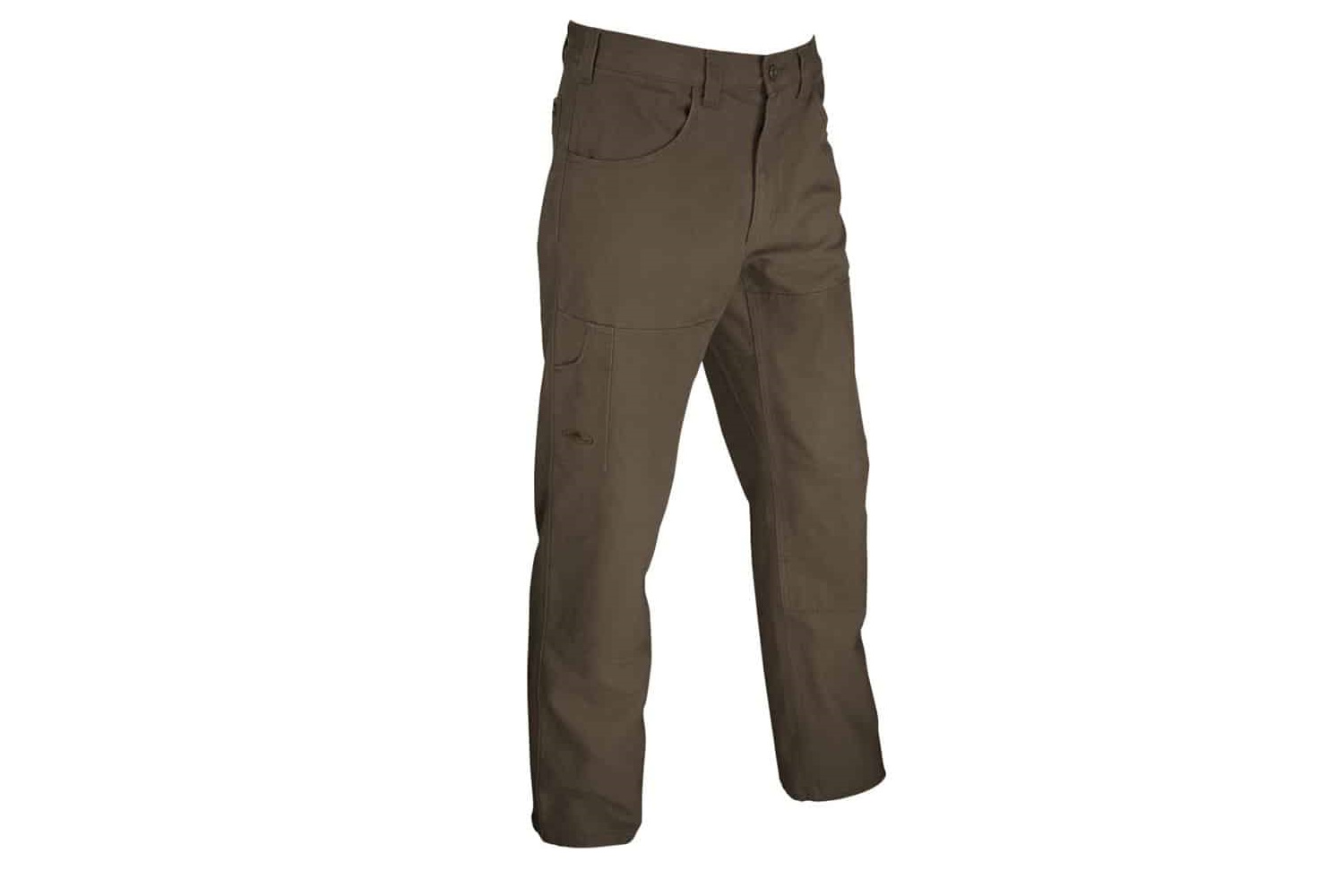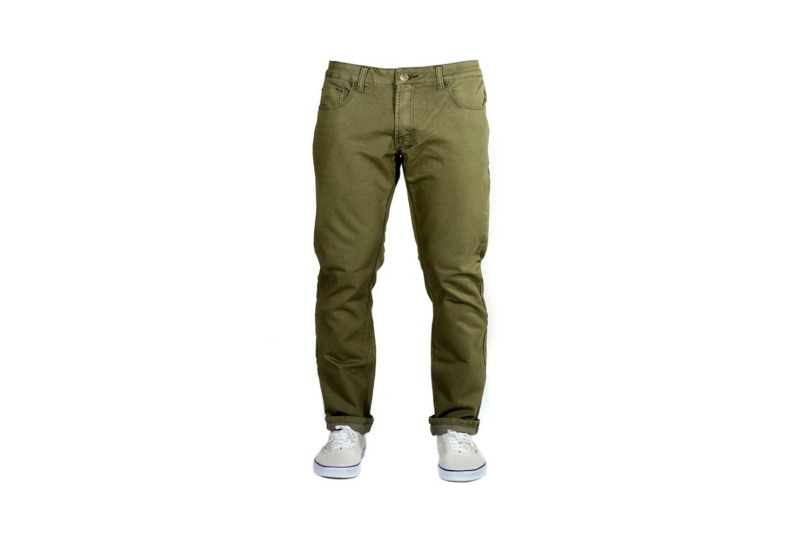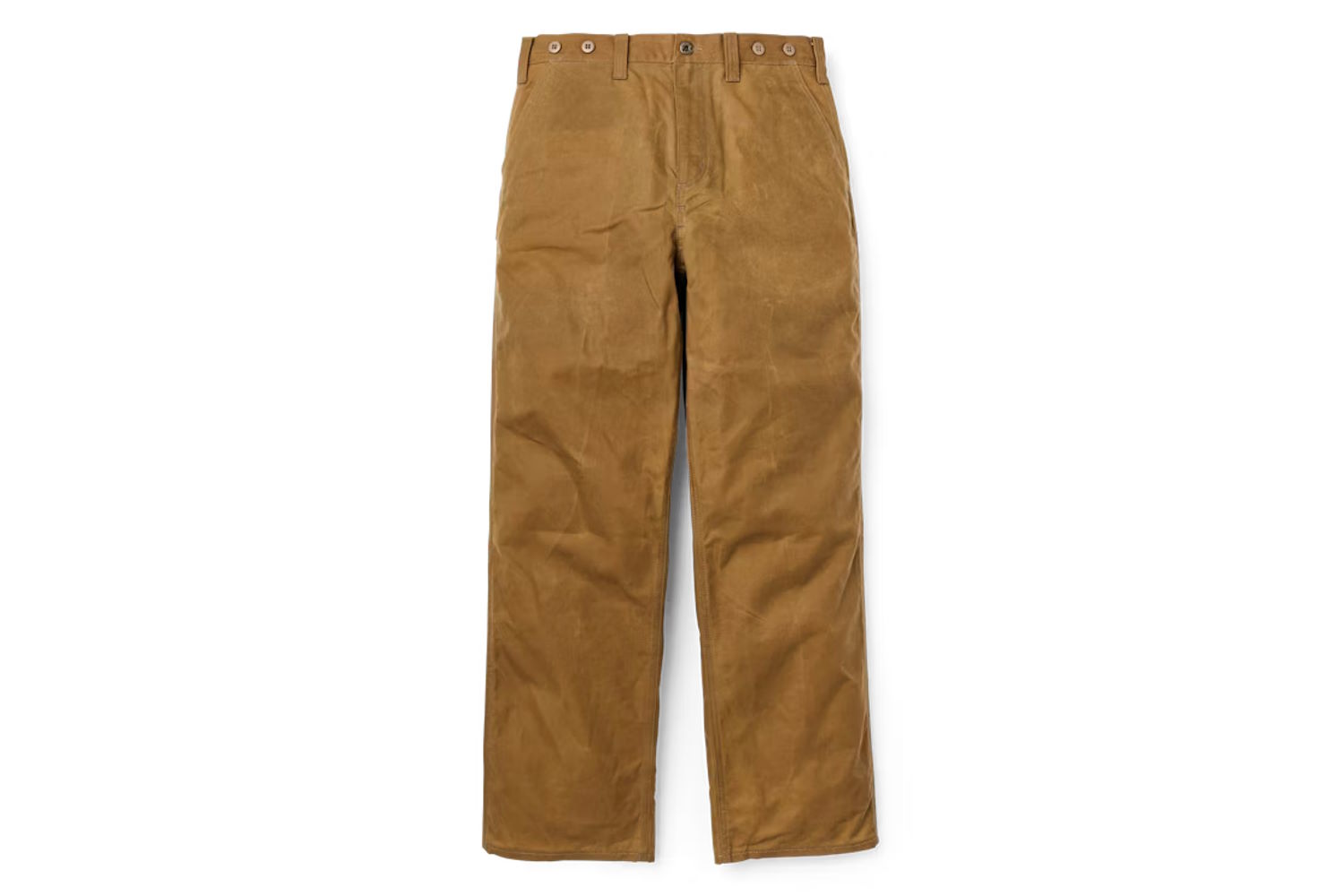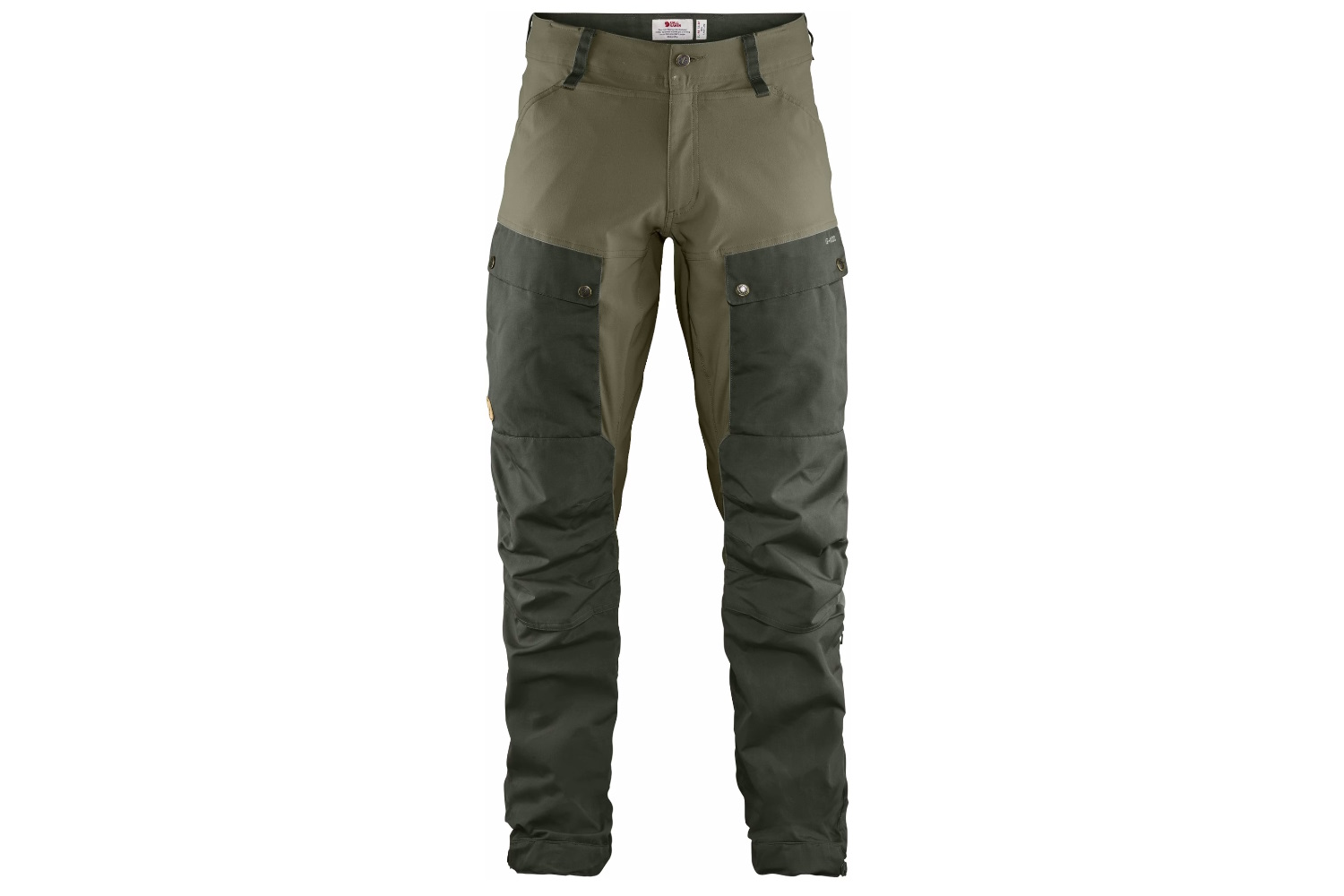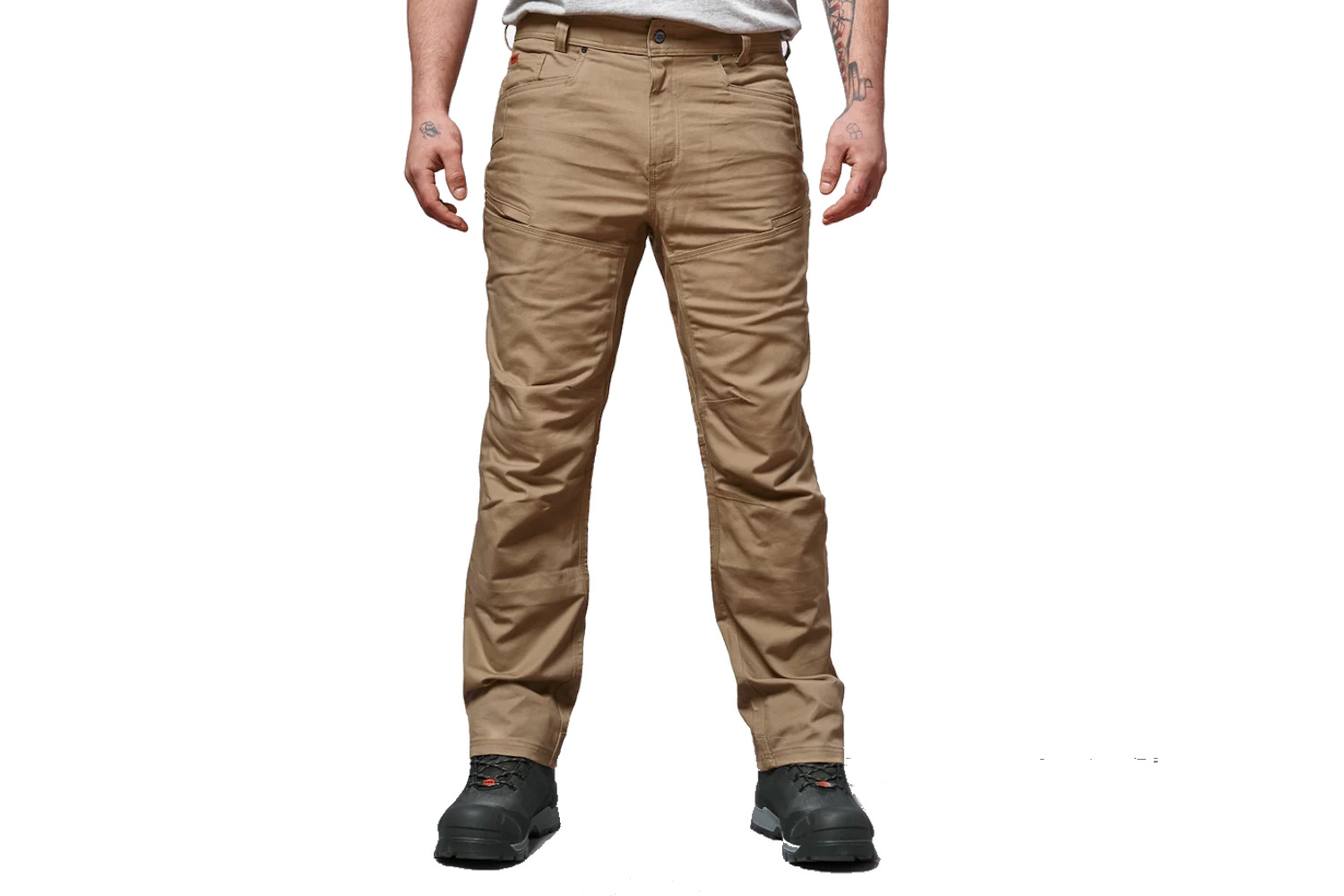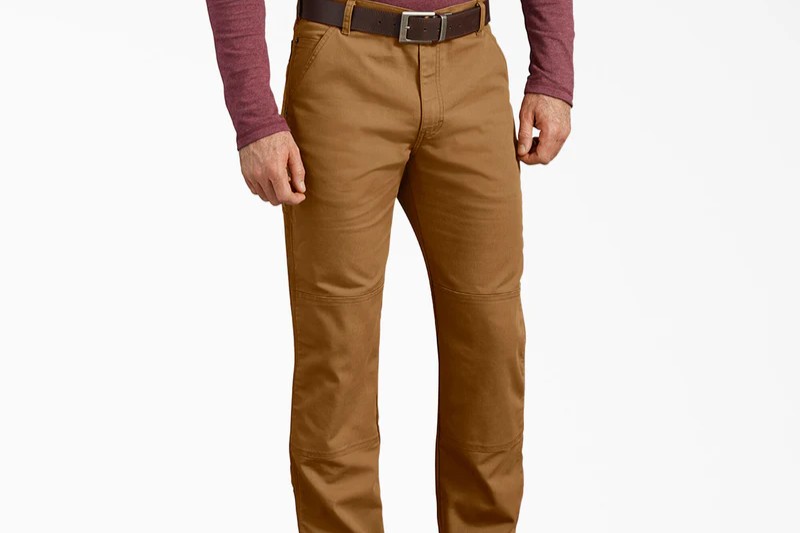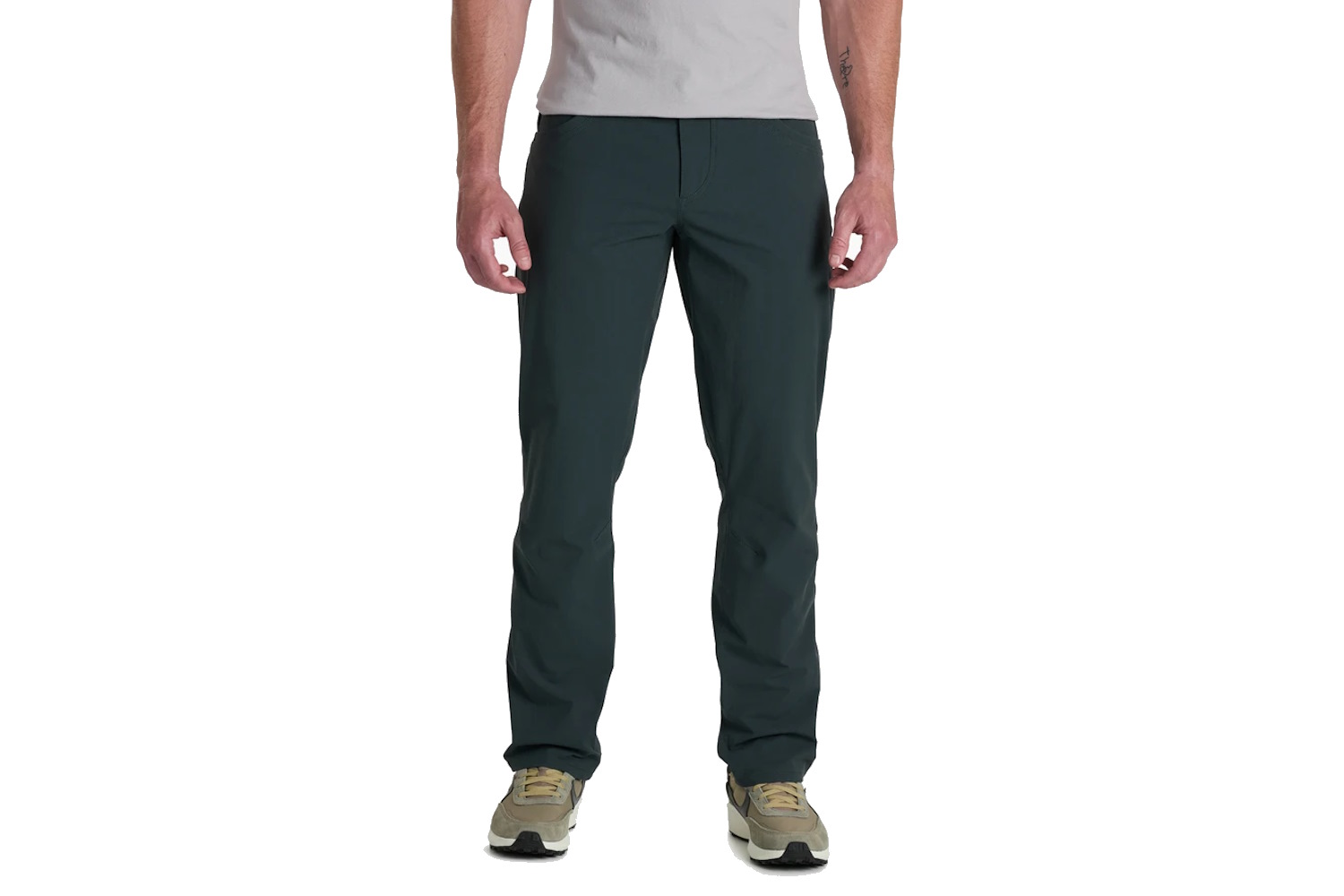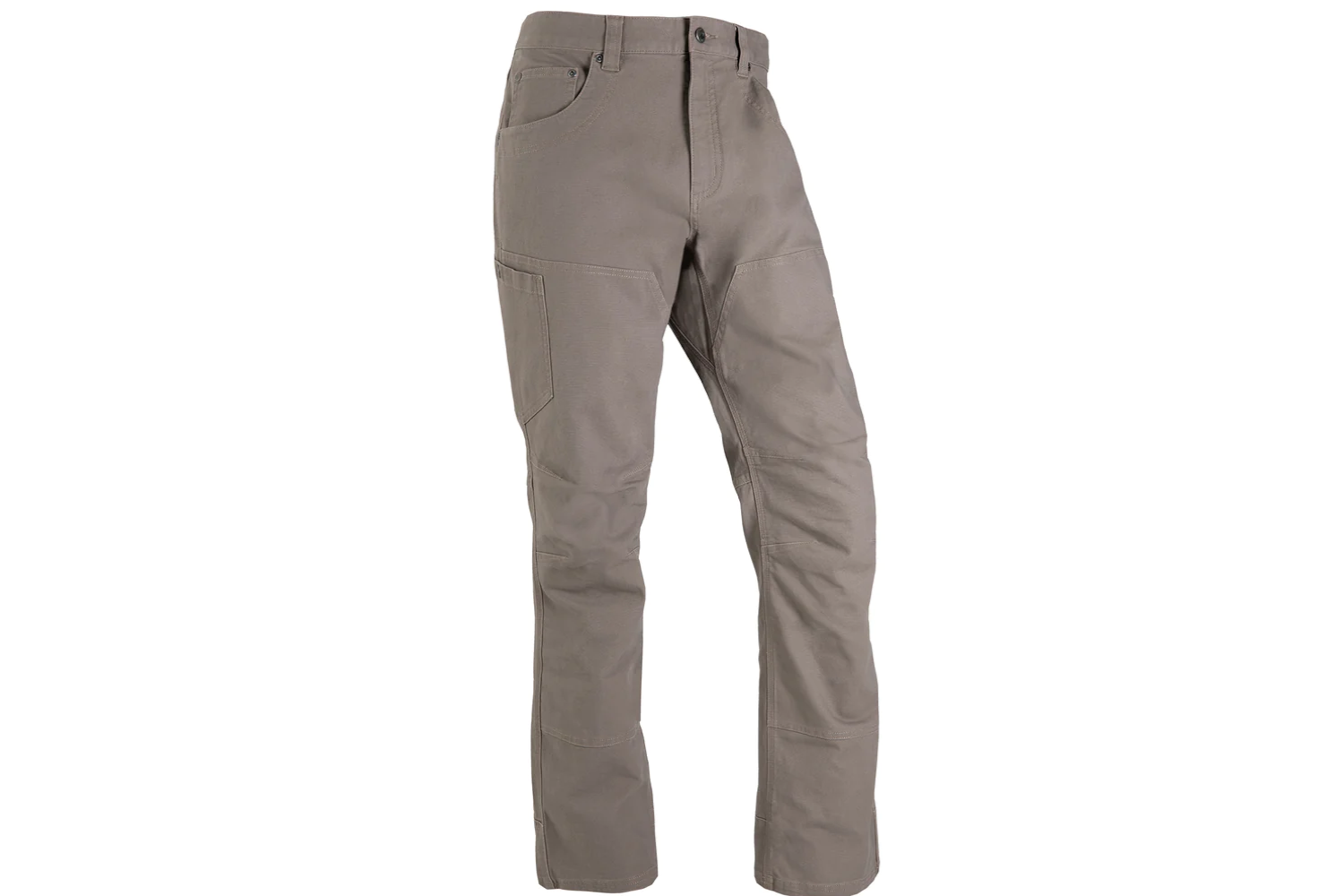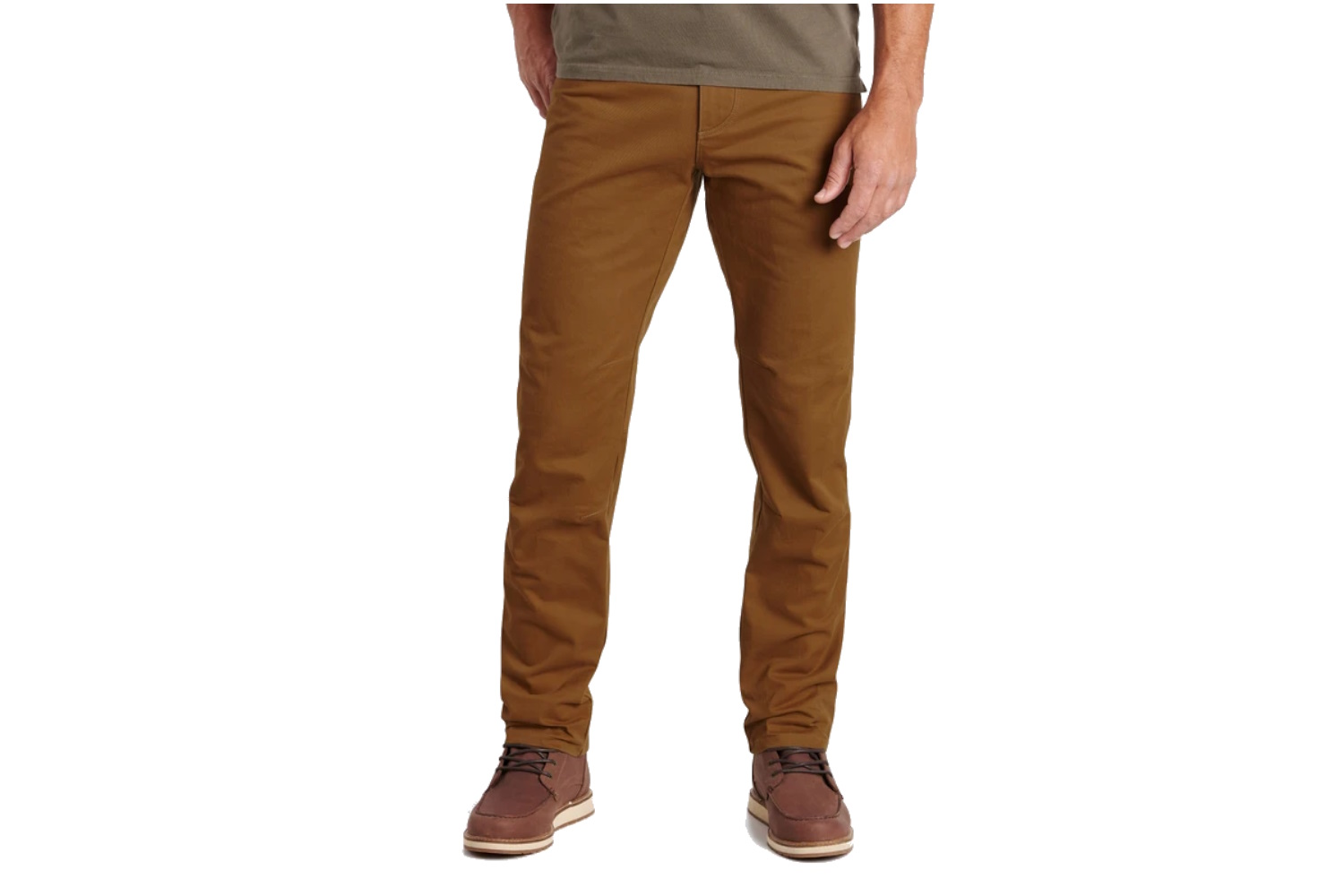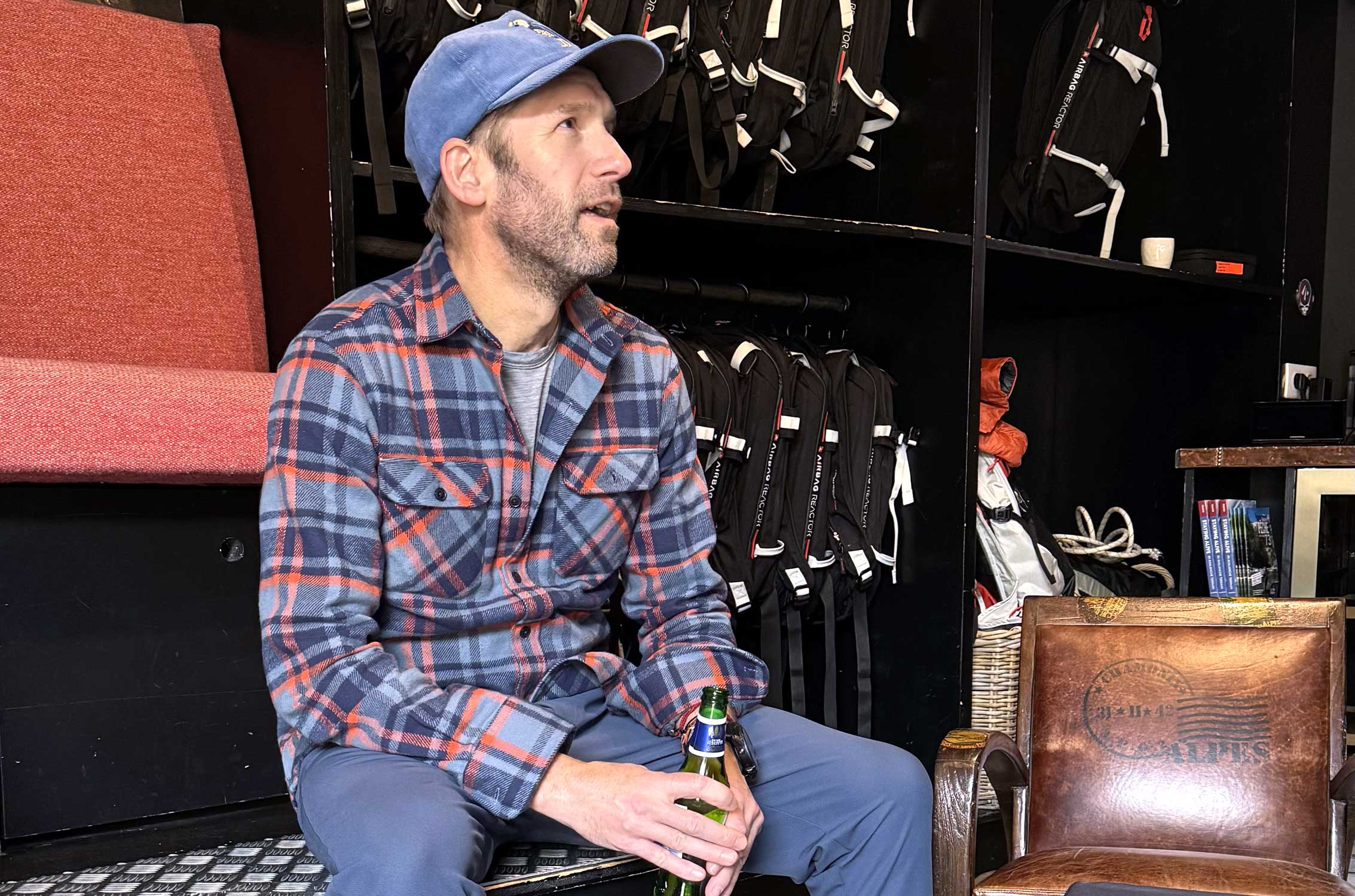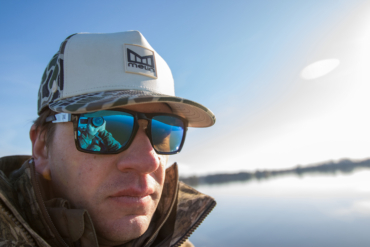Kneeling for hours in grubby conditions, fending off sparks and debris, stashing greasy tools — work pants have to deal with a lot. Whether you are a professional tradesman, or DIY fiend paying your dues on personal projects, narrowing in on the best work pants for your needs is important for efficiency and safety on the job site.
Our team has collectively put hundreds of different work pants through the wringer on tasks around homesteads, construction jobs, and everyday yard work. When assessing work pants, we consider how well the pants do hard jobs while protecting the body. We also consider durability and how it relates to pricing, comfort, and overall construction.
The pants below will suit many full-time tradesmen. They will easily suffice for the weekend DIYer or someone who needs something a bit tougher than jeans (especially those new soft, stretchy ones) but are probably not going as far as adding a tool belt to their ensemble.
Editor’s Note: We updated the Work Pants guide on November 21, 2025, to add our new favorite work jeans, the Bulletprufe Denim 5th Gen Jeans, as well as the Dickies FLEX Duck Double Knee Pants.
The Best Work Pants of 2025
1620 Workwear Double Knee Utility Pant 2.0
-
Fit
9.0
-
Mobility
8.8
-
Durability
8.9
-
Value
8.0
- Fabric: Cordura stretch NYCO
- Utility Pockets: Back yoke welt pockets, dual watch pockets, right phone pocket, right zip key pocket, military-spec shank button, dual hammer loops, left leg utility pocket
- Water Resistance: DWR coating
- Fit: Regular
Pros
- Stellar pocket layout
- Tough NYCO fabric
Cons
- Expensive
Carhartt Rugged Flex Utility Double Front Pant
-
Fit
8.0
-
Mobility
7.9
-
Durability
6.5
-
Value
7.0
- Fabric: 12 oz, 99% cotton, 1% spandex Duck
- Utility Pockets: Deep front pockets, left and right phone pockets, right utility pocket, right hammer loop, reinforced back pockets, knee pad pockets on front of legs
- Water Resistance: No
- Fit: Slim
Pros
- Comfortable off the shelf
- Durable and flexible Carhartt Duck fabric
- Simple pocket layout
Cons
- Less durable than the unwashed Duck (Firm Duck)
Arborwear Original Tree Climbers’ Pants
-
Fit
7.9
-
Mobility
6.8
-
Durability
9.5
-
Value
8.0
- Fabric: 100% cotton ringspun canvas
- Utility Pockets: Utility pocket on right thigh
- Water Resistance: N/A
- Fit: Classic
Pros
- Extremely durable
- Tough knee reinforcements
Cons
- Utility pocket on thigh is quite small and restricting
- Not very stretchy
Bulletprufe Denim 5th Gen Jeans
-
Comfort
9.0
-
Mobility
8.0
-
Durability
8.0
-
Value
6.5
- Fabric: Proprietary quad-blend rip-stop (ballistic nylon, cotton, polyester, & spandex)
- Utility Pockets: None
- Weather Resistance: None
- Fit: Adventure & Slim
Pros
- Insanely Comfortable
- Flexible
- Durable
Cons
- Priced like designer jeans
Filson Oil Finish Single Tin Cloth Pants
-
Fit
8.1
-
Mobility
7.5
-
Durability
8.8
-
Value
7.3
- Fabric: 100% 14 oz cotton oil finish tin cloth
- Utility Pockets: Deep front and rear pockets
- Water Resistance: Oil wax finish
- Fit: Classic
Pros
- Extremely durable
- Wax finish makes them virtually stain-proof
- Built-in suspender buttons
Cons
- Can stain light-colored clothing from prolonged contact
- Expensive
Fjällräven Keb Trousers
-
Fit
8.7
-
Mobility
6.9
-
Durability
8.9
-
Value
6.0
- Fabric: Waxed G-1000 — 65% polyester (recycled), 35% cotton (organic)
- Utility Pockets: 2 leg pockets with buttoned flaps, mesh pocket inside one of the leg pockets
- Water Resistance: PFC-free water-resistant wax coating
- Fit: Regular
Pros
- Hip-to-knee and lower leg ventilation zippers
- Reinforced knees with openings for pads (kneepads not included)
- Extremely durable
- Sustainable build
Cons
- Heavy
- Not the most flexible
- Not the best next-to-skin comfort
- Pricey
BRUNT Workwear Martin Pant
-
Fit
8.5
-
Mobility
8.2
-
Durability
8.1
-
Value
8.2
- Fabric: 8.5 oz. blend of cotton (70%), nylon (28%), and spandex (2%)
- Utility Pockets: Deep right-side tool pocket, Deep left-side zippered pocket, Angled back pockets
- Water Resistance: DWR Coating
- Fit: Regular
Pros
- Incredible balance between durability and flexibility
- Moisture-wicking waistband
- Gusseted crotch for ease of movement
- Double-front
Cons
- The zipper on the left utility pocket is overkill
- They wrinkle easily
Other Great Work Pants Tested
-
Comfort
7.8
-
Mobility
8.2
-
Durability
6.8
-
Value
8.0
- Fabric: 9 oz.. Duck: 68% Cotton, 30% Polyester, 2% Lycra
- Utility Pockets: Tool pocket on right thigh
- Weather Resistance: None
- Fit: Regular
Pros
- Lightweight 9 oz. Duck Fabric
- Durable
- Roomy but fitted
Cons
- Waist is larger than standard sizing
Dickies and Carhartt are the two brands that are most synonymous with “work pants.” its FLEX Duck Double Knee ($50) are classic double-knee work pants without the bulk or rigidness. Off the shelf, they are supple and well broken in. On the job, they’re durable and comfortable and ready to take on any task.
In testing, we found the FLEX Duck Double Knee pants were roomy but not baggy. This allowed us to stuff our pockets with socket wrenches, sockets, and screwdrivers – along with a wallet, keys, cell phone, and earbuds. Even fully loaded, they didn’t feel restricted or like they were being pulled down. This was fantastic, considering the waist was looser than all the other pants we tested in the same size. This is part of the design that aids in your ability to move around, but make sure to pair these with your favorite work-worthy belt.
Though the FLEX Duck Double Knees don’t have any weatherproof treatment listed in its features, we found that snow, light rain, and dropped liquids rolled off the pants instead of soaking in. In both clearing snow and working through a rainstorm, this was a nice surprise that kept us dry and working.
Though we still prefer the Carhartt Rugged Flex Utility Double Front pants to these, if you’re looking to save a few dollars or if you prefer lightweight pants, the Dickies FLEX Duck Double Knee offer a viable alternative.
-
Fit
7.8
-
Mobility
8.1
-
Durability
8.3
-
Value
7.0
- Fabric: XKanvas: 65% cotton, 26% nylon, & 9% spandex
- Utility Pockets: 3D drop-in right-side pocket, drop-in left-side phone pocket
- Water Resistance: DWR Coating
- Fit: Regular
Pros
- Great stretch and mobility, but fabric rebounds and doesn't bag over time
- Solid durability
- Soft next-to-skin feel
- Gusseted crotch for more freedom of movement
- Cuff guards at the bottom hem
Cons
- No knee reinforcement
- Right drop-in pocket is a bit loose and not very deep
- Thick stitching on hand pockets makes it a bit hard to slide a knife clip into them
-
Fit
7.9
-
Mobility
7.8
-
Durability
6.1
-
Value
7.0
- Fabric: 8.7 oz. 98% cotton, 2% spandex canvas
- Utility Pockets: Right coin pocket, right drop-in pocket with snap
- Water Resistance: DWR coating
- Fit: Classic
Pros
- Soft next-to-skin feel
- Reinforced knees and cuffs
Cons
- Not the most durable
-
Fit
7.0
-
Mobility
8.0
-
Durability
7.5
-
Value
7.0
- Fabric: Cotton/spandex Eurotwill
- Utility Pockets: Side drop-in pocket
- Water Resistance: N/A
- Fit: Regular
Pros
- Just enough elastic for stretch without sacrificing durability
- Reinforced hem and pocket lips
- Comfortable fabric
Cons
- No reinforced knees
Work Pants Comparison Chart
| Work Pants | Price | Fabric | Utility Pockets | Water Resistance | Fit |
|---|---|---|---|---|---|
| 1620 Workwear Double Knee Utility Pant 2.0 | $198 | Cordura stretch NYCO | Back welt pockets, dual watch pockets, right phone pocket, right zip key pocket, shank button, dual hammer loops, left leg utility pocket | DWR coating | Regular |
| Carhartt Rugged Flex Utility Double Front Pant | $60 | 12 oz, 99% cotton, 1% spandex Duck | Deep front pockets, left and right phone pockets, right utility pocket, right hammer loop, reinforced back pockets | N/A | Slim |
| Mountain Khakis Camber 107 Pant | $60 | 98% cotton, 2% spandex canvas | Right coin pocket, right drop-in pocket with snap | DWR coating | Classic |
| Arborwear Original Tree Climbers’ Pants | $95 | 100% cotton ringspun canvas | Utility pocket on right thigh | N/A | Classic |
| Filson Oil Finish Single Tin Cloth Pants | $195 | 100% 14 oz. cotton oil finish tin cloth | Deep front and rear pockets | Oil wax finish | Classic |
| Bulletprufe Denim 5th Gen Jeans | $128 | 50% cotton, 35% nylon, 10% polyster, 5% spandex | Standard jean 5-pocket layout | N/A | Adventure & Slim |
| BRUNT Workwear Martin Pant | $129 | 70% cotton, 28% nylon, 2% spandex | Deep right-side tool pocket, Deep left-side zippered pocket, Angled back pockets | DWR coating | Regular |
| KÜHL Resistor Jeans | $129 | 65% cotton, 26% nylon, 9% spandex | 3D drop-in right side pocket, drop-in left-side phone pocket | DWR coating | Regular |
| Dickies FLEX Duck Double Knee Pants | $50 | 68% cotton, 30% polyester, 2% elastane | 2 side pockets, 2 back patch pockets, hidden tool pocket | N/A | Regular |
| Fjällräven Keb Trousers | $240 | Waxed G-1000: 65% polyester, 35% cotton | 2 leg pockets with buttoned flaps, mesh pocket inside one of the leg pockets | PFC-free water-resistant wax coating | Regular |
| KÜHL Free Rydr | $99 | Cotton/spandex Eurotwill | Side drop-in pocket | N/A | Regular |
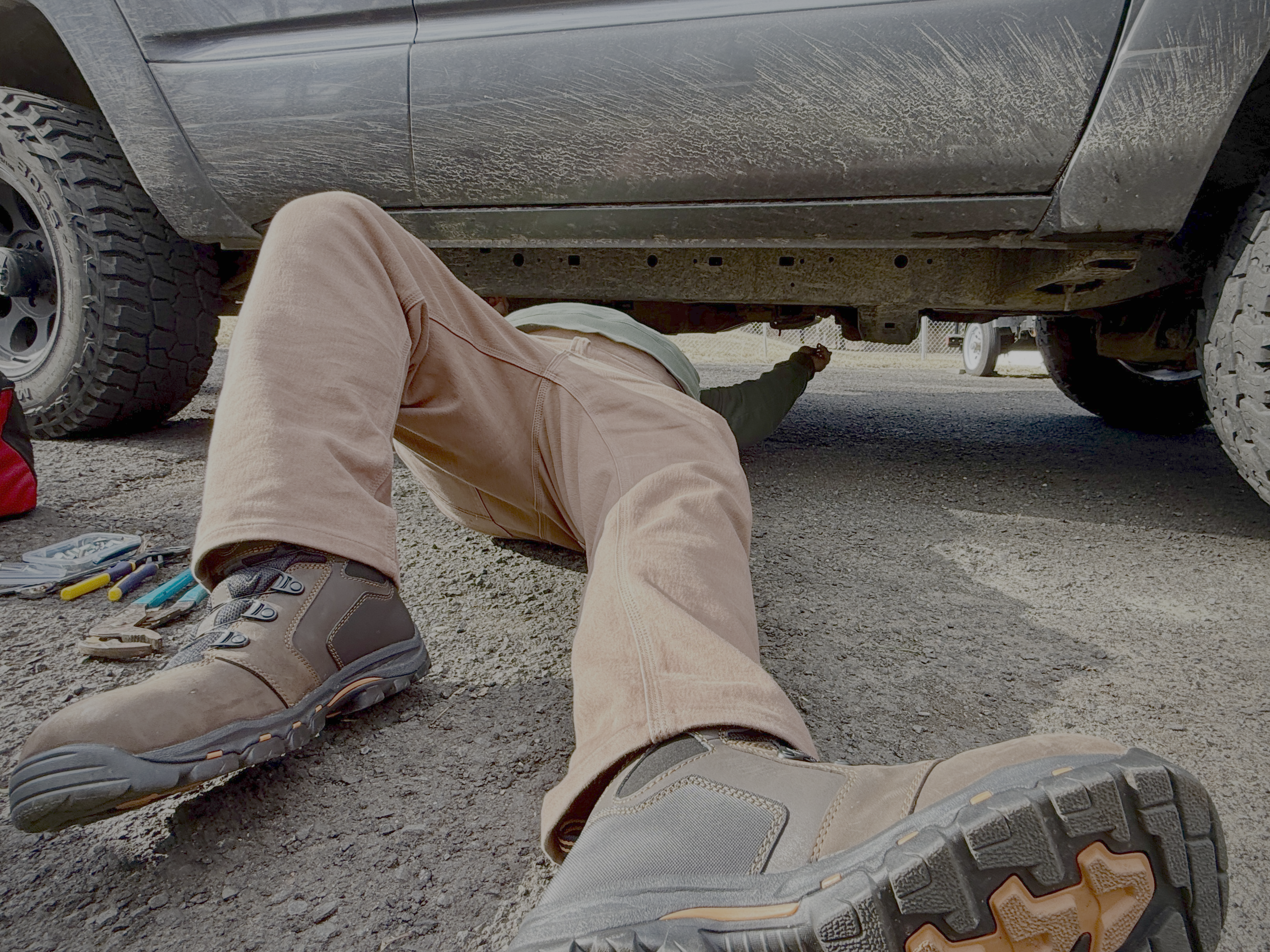
How We Tested the Best Work Pants
Work pants are meant to be worn when you’re busting your butt getting work done at home, on the jobsite, and wherever else laborious tasks take you. Sure, they look great when you’re standing in line at the coffee shop or draining a couple of cold ones after a long day, but aside from increasing your already rugged good looks, they are built for abuse.
From full-time homesteaders to construction workers and passionate tinkerers ticking off personal projects over the weekend — the GearJunkie team knows how to get their hands dirty. To accommodate their lifestyles, they’ve put countless models of work pants through the wringer on just as many job sites and pooled their collective experience to form this comprehensive guide.
Our Expert Testers
Editors Chris Carter and Sean McCoy joined forces with contributor Nick LeFort to curate the streamlined selection of six pants you see today. They bucked logs in the backcountry, chipped away at construction projects, and generally abused a whole slew of work pants to narrow in on the best of the best.
We asked them to really experience the pants they were testing. They worked and played in these curated pants to prove their worth — blood, sweat, and tears. So, rest assured, we would rely on any of the models above to tackle demanding jobs.
Our Testing Process
We know that the work pants podium is competitive and constantly evolving, which is why we’ve slotted this guide into an iterative update schedule. We are perpetually scouring the internet, attending gear shows, and bugging the pros to make sure we test and review the most current, deserving pants on the market.
When we find a new pair of pants for any of our testers to vet, they spend upwards of two to three months in them. At GearJunkie, we have found that to truly test any of the products that we do — especially clothing — sometimes we need to experience them outside of the realm of their purpose. After all, that’s what any of us would be doing with the clothing and gear we use.
Our Work Pant Rating System
Each work pant in this guide was tested and scored in four main categories: Fit, Mobility, Durability, and Value.
Fit considers the first thing that you notice when you try on a pair of pants. Are slim fitting pants a good blend of slim and flexible? Do regular fit pants give you room to breathe? Are they true to size? If a pant fit the way we expected it to, it generally received a good rating.
Mobility looks at how well the pants move with you. We tested the pants in a wide range of motion: we squatted, high-stepped, lunged, and took pants through our normal work days. If the pants allowed us to move freely, they received a better score.
Durability measures a pant’s toughness. Reinforced knees, tough fabric, and other factors were considered. If we saw any fraying or signs of wear during the course of our testing, those pants would get dinged.
Value can be subjective, but we weighed a pant’s cost versus its use and utility. If a pricier pair of pants earned it’s high price tag, it received a better score. Likewise, if a less expensive pair of pants falls apart after a few weeks, it’s not worth the price of admission.
The overall score is not a simple average of these categories. Instead, it reflects our editorial judgment based on the complete user experience. That means a less durable pant with an extremely high mobility range can still score high, while a pant with a lower durability might rank higher for its excellent fit and low price.
F
Buyer’s Guide: How to Choose the Best Work Pants
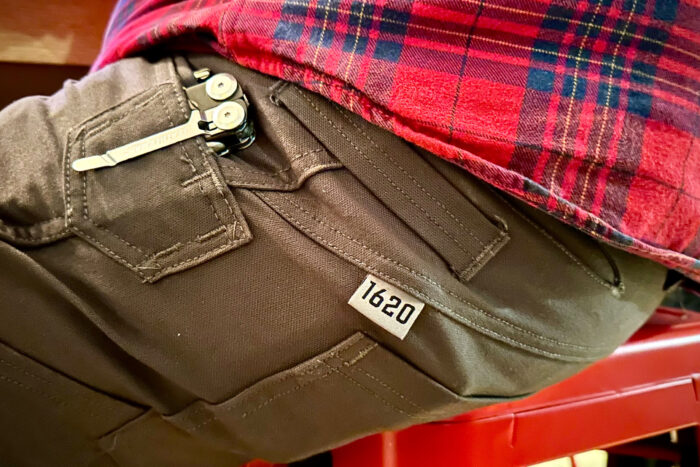
Like most things out there, work pants come in all shapes and sizes, and there are enough options to make your head spin. Since you’ll be doing more in these pants than just walking or hanging around, it’s important to consider the materials, features, and intended use of work pants before making your selection.
We’ve highlighted a number of our top picks above, but are continually testing more models as they come out and updating our list of favorites. Though brands like Carhartt, 1620, and Arborwear keep showing up in our rotation, there are a lot of brands out there vying for the top slots.
The two key factors in picking the best pair of work pants for you are fit and function. Each brand has its own cut or silhouette. And while we try our best to describe how each of the above pairs of pants fit us, the only way to really know how they fit you is by trying them on.
Additionally, each brand has its own take on fabric. Whether it’s something off the shelf or proprietary to the brand, the amount of different fabrics out there for work pants is pretty impressive. But these different fabrics can change the way pants fit and perform.
When shopping at a store, that’s easy to solve by jumping into the fitting room. But when buying a brand for the first time online, be sure to check out its return policy in case they don’t fit how you like and you need to send them back.
Pro tip: Order a few different sizes in the first batch to avoid a bunch of shipping back and forth. Try them all on and just send back the pairs that don’t fit right.
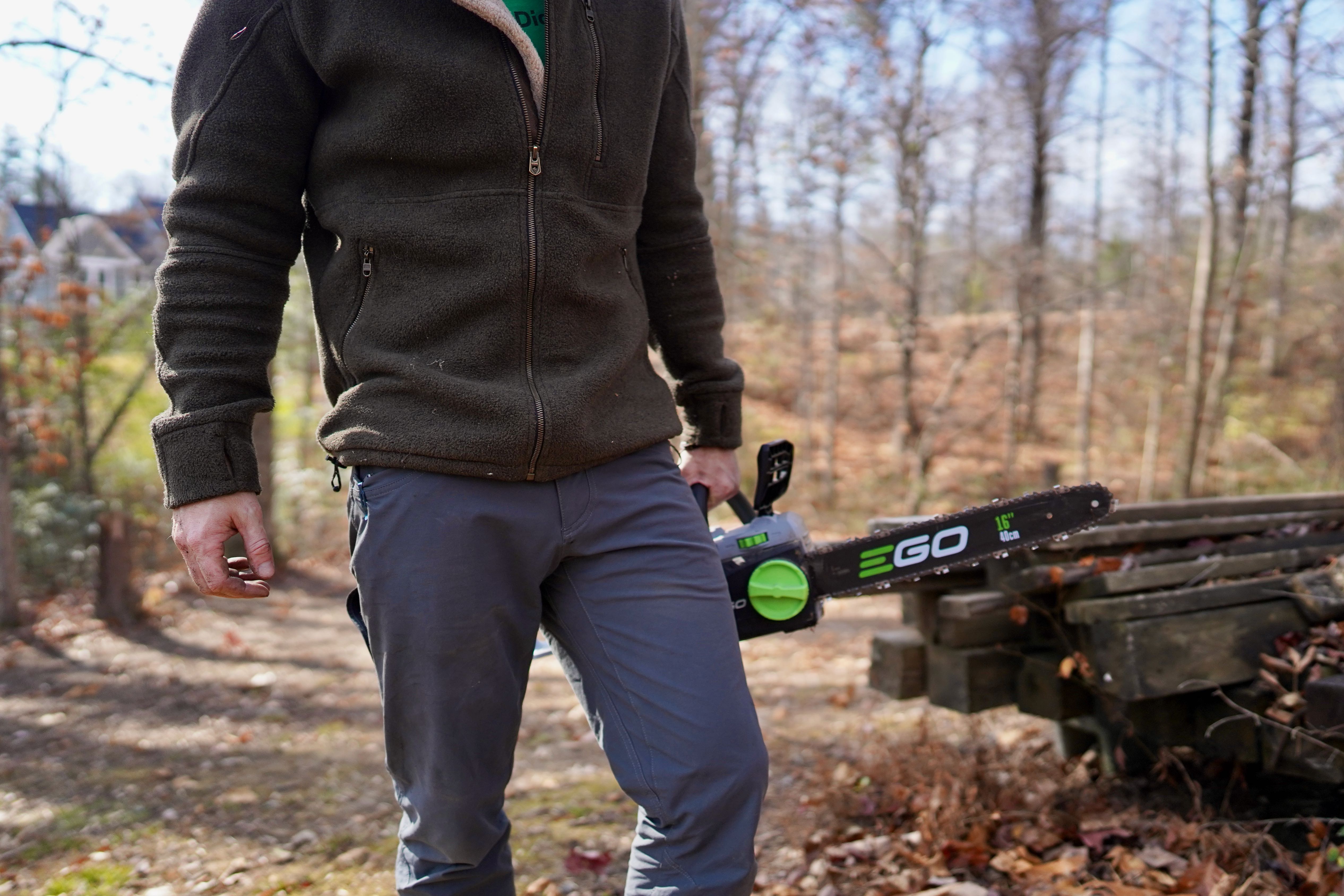
Things to consider are features like articulated knees or a gusseted crotch. These are important depending on how much squatting, kneeling, or climbing you will be doing in the pants. A pair of pants that don’t fit well won’t get worn or will just cause endless frustration.
The second factor is function. Some key features to consider are pocket configuration, reinforced areas (pockets, knees, hemlines, etc.), hammer loops, and the ability to take knee pads. These vary in importance depending on what you will be doing in these pants. Below, we’ll take a look at what makes a good pair of work pants.
The last thing to consider when choosing the right work pants is how they perform when you’re done working. Would be caught dead food shopping in them? How about a night out on the town? Or even an apres work beer? Part of feeling comfortable is looking the part. You’re not always going to run home to change before you start living the leisure part of life.
It’s also worth noting that this guide covers features and materials specific to sturdy work pants, which tend to fit pretty niche purposes. For information on other outdoor pants categories, check out our comprehensive guides on the Best Hiking Pants and the Best Travel Pants.
Fit Categories of Work Pants
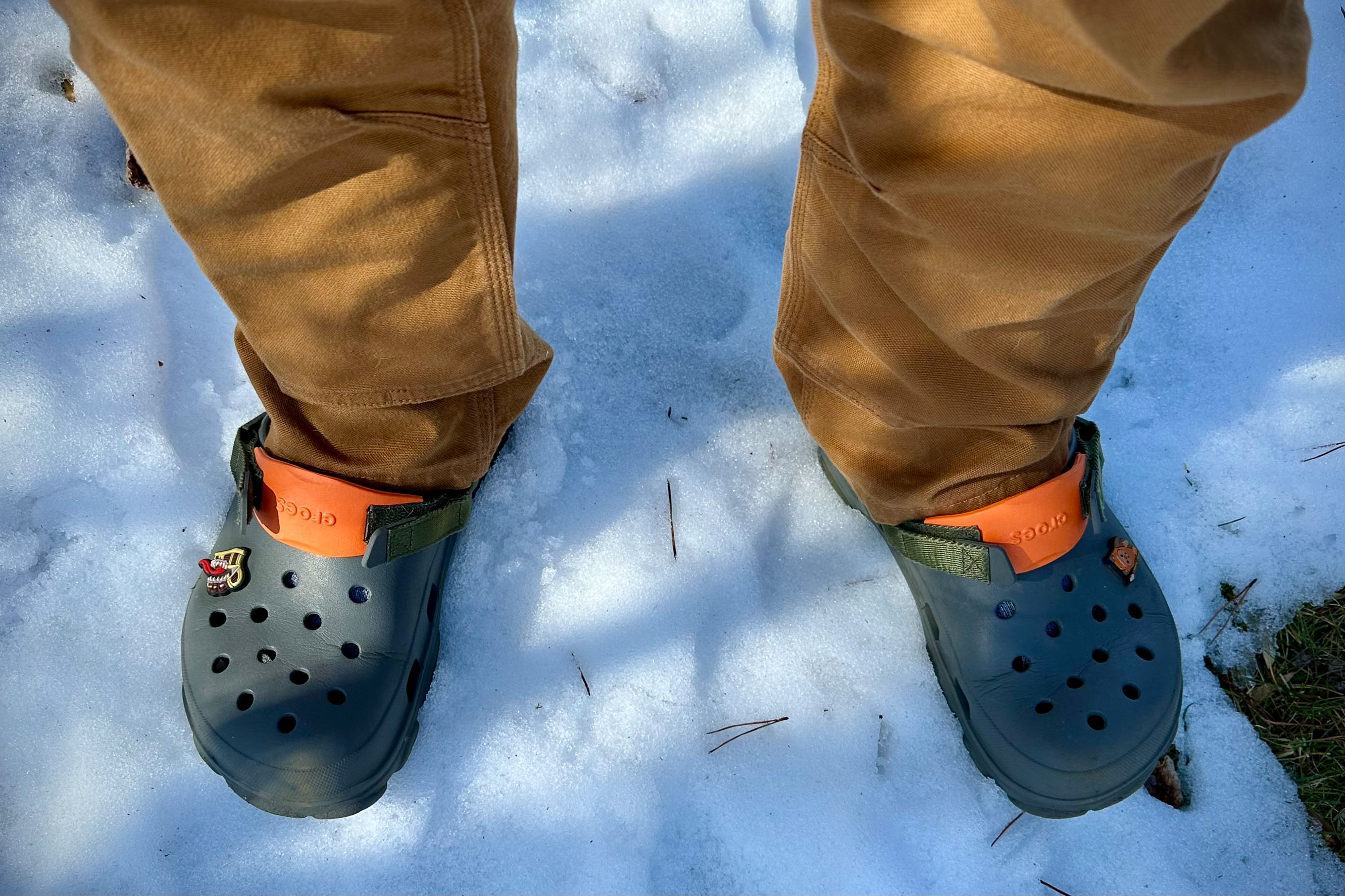
Work pants, as with other pants, fall into a few different categories that can give you an idea of how they will fit without actually trying them on. Most work pants fall into one of the following categories: relaxed, regular, classic, or slim.
- Relaxed: These are some of the more comfortable-fitting pants, offering roomy fit in the seat, thigh, and ankle. These run on the baggy side, but eschew the stiffness that often accompanies tighter-fitting pants. This boils down to personal preference, but we tend to avoid relaxed fits while we are working, as we don’t want anything to get in our way while making precision cuts or lunging over a pile of lumber. For us, it’s important to find a healthy balance of a tapered form fit with enough stretch to easily move about.
- Regular: These pants strike a healthy balance between relaxed and slim pants. They don’t offer as much room in the seat and thigh but aren’t necessarily form-fitting. These are easy to move in without being too tight. Regular pants often have a straight leg opening, and sit slightly below the waist.
- Classic: The line between regular and classic can sometimes be blurred, but as a general rule classic pants also have a straight leg opening, but run more on the slim side than regular. They can have a flat or pleated front and usually sit at the waist. This is our author’s personal favorite — as long as they have enough flexibility built into the fabric.
- Slim: These pants aren’t necessarily “skinny jeans” status, but do sit much closer and tighter to the leg. The leg openings will still allow you to wear heavy work boots underneath but are much more form-fitting than the other categories. If you can’t stand the baggy look, these are the pants for you.
The type of pants you go with purely depends on personal preference and the type of jobs you plan to be tackling in them.
Features of Work Pants
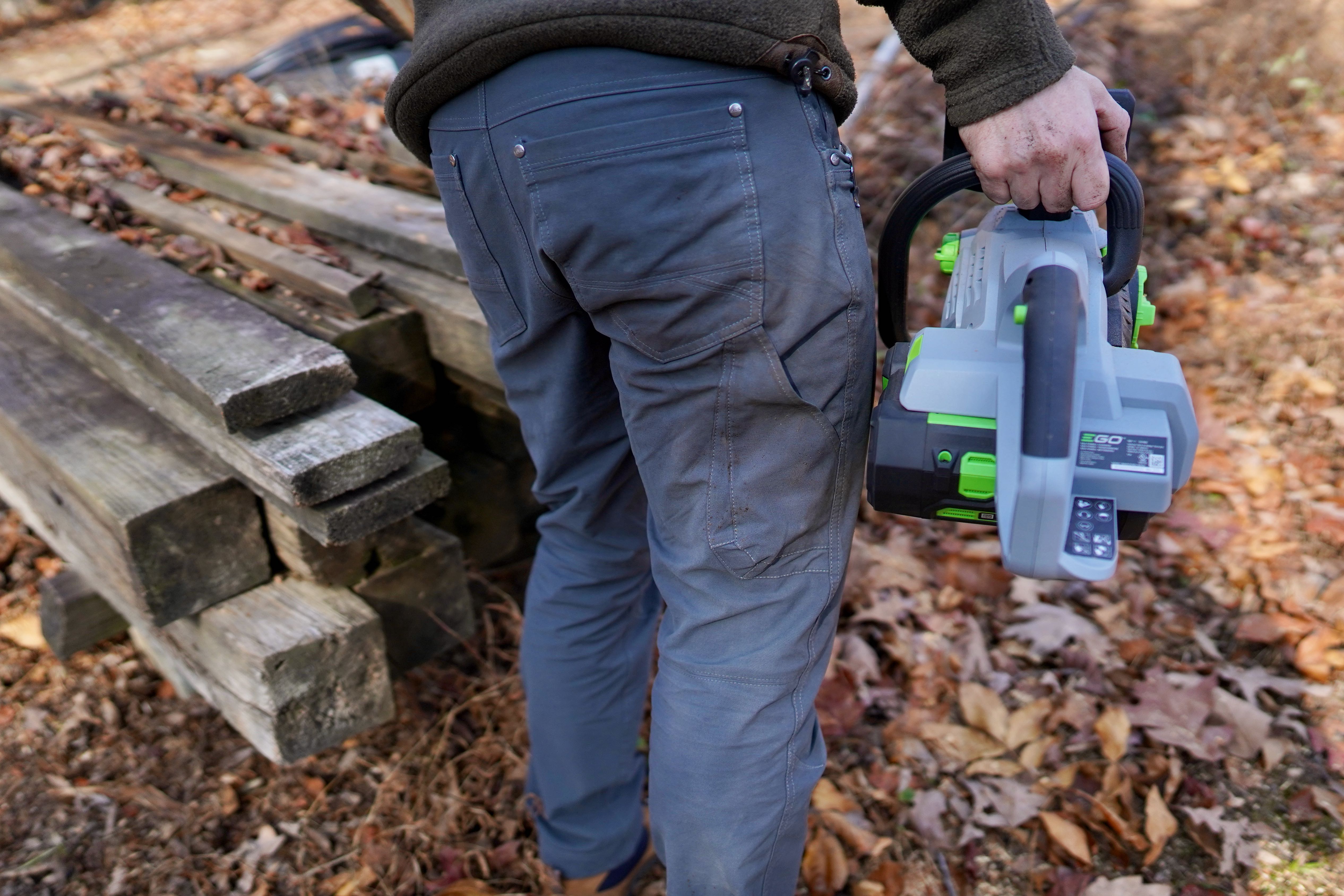
The feature sets on work pants are diverse and job-specific and contribute to their useability. Consider the type of tasks you want to accomplish in your pants and select a feature set accordingly. While it may seem awesome to have a million pockets, loops, and zippers on your pants, these can get in the way if your job requires you to be quick and mobile. Additional features add fail points to the pants and contribute to the overall weight. They can also reduce the ventilating abilities of the pants — so choose with care.
Gusseted Crotch
We are seriously skeptical of work pants if they don’t have these. A gusseted crotch is a diamond-shaped piece of fabric sewn into the crotch area. A gusset eliminates four seams coming together where the legs join, which limits mobility and can be uncomfortable. A gusset also helps disperse stress around the crotch, boosting pants’ durability and making it easier to crouch down or high-step over obstacles.
Articulated Knees
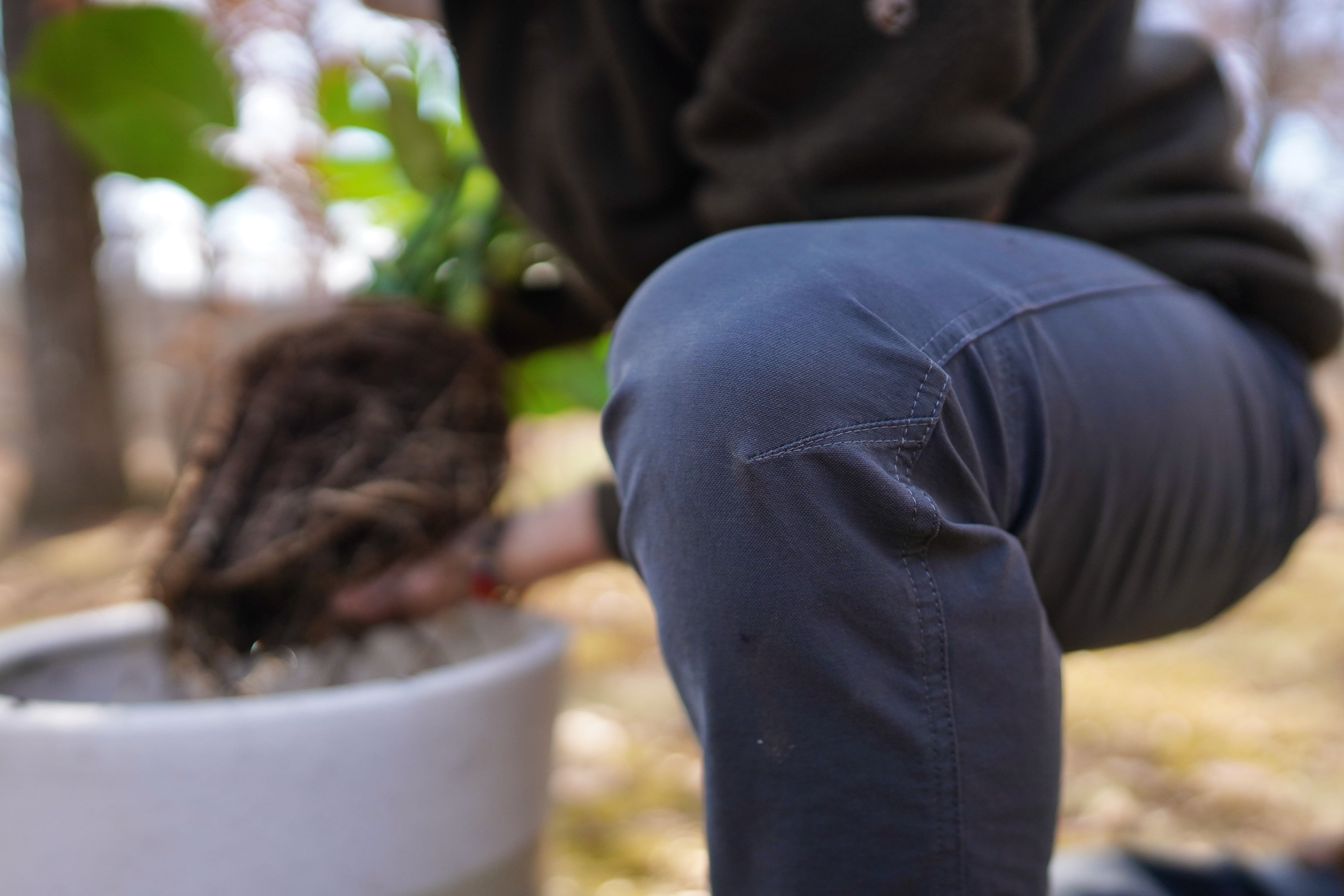
Similar to gusseted crotches, articulated knees provide a bit more flexion in the knee area allowing you to bend and kneel more easily. These come in incredibly handy if you find yourself climbing up and down a ladder or navigating scaffolding at your work site. Articulated knees are created by sewing “darts” — a seamstress term for a simple fold sewn into the pant’s material — into the knees, like in the photo above.
Reinforced Areas
Kneeling for hours on rocky ground, sitting on rough concrete, or rubbing against abrasive surfaces — work pants deal with loads of abuse. It’s not uncommon to see extra patches of thicker fabric sewn over high-use areas like the knees or rear in these stalwart trousers. These afford extra protection for your legs, while also prolonging the life of your pants. Just be aware that reinforcement patches add weight and extra stitching, and can limit the pant’s ventilation.
Extra Pockets and Loops

Work pants are often specced out with some seriously sweet accessories, like dedicated phone pockets, zip and cargo pockets, shank buttons, or hammer loops. These can all be used to store EDC items like knives, phones, and multitools, and also allow you to quickly stash tools or materials as they amass mid-job.
We particularly appreciate side drop-in pockets — if they are deep and tight enough — for throwing a handful of nails or screws in if we are going to be standing in one place for a while putting something together. These aren’t often the most secure pockets (unless they are zippered or buckled closed), so it’s best to not keep dangerous materials in them for too long.
Materials and Durability of Work Pants
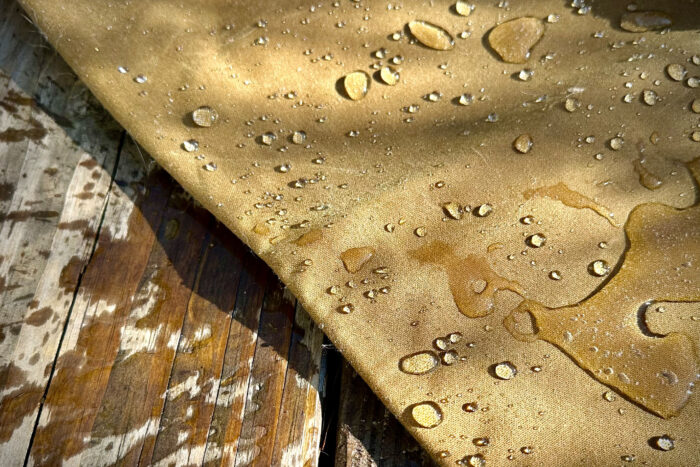
Of all the pants in our closet, work pants are the most battle-ready. Reinforcement patches, thick stitching, and expensive materials generally decorate these models, and they are designed to withstand years of torture. These features make work pants great for more than just a job site. We find ourselves grabbing them for backcountry bushwhacks, motorcycle tours, and any activity that would threaten to shred our legs.
Work pants are usually constructed with several different materials, blending fabrics to deliver the highest quality of each material. Here are some of the primary materials used in work pants:
- Cotton/Cotton Duck: Cotton is the most widely used natural fiber in the world today, and most work pants have a certain degree of cotton in them. Cotton is the foundation of other fabrics, such as denim and duck. As we all know, however, cotton has its downsides. Namely, it can shrink, is prone to wrinkling, and dries very slowly if it gets wet. Cotton duck is a tightly woven cotton fabric and is tougher than denim. It is likened to a canvas fabric and is incredibly resistant to softening over time — which is a downfall of denim. It is quite tear-resistant and has even been used to construct things like hammocks and sails.
- Spandex/Lycra: this material has great flexion, but returns to its normal shape and structure. Spandex isn’t used generously in work pants but is an important element in the blends that manufacturers use. You move around a lot in work pants, and there needs to be some give to accommodate all the needs of an active job site. Spandex isn’t particularly durable though. Spandex is frequently added to the waistband of pants to afford more stretch and comfort.
- Cordura: This is a super tough material that is highly tear- and abrasion-resistant. Cordura is often used in reinforcement patches and high-stress areas to prolong the life of pants.
- Polyester: Compared to cotton, polyester is incredibly strong and durable. It dries out much faster than cotton and doesn’t absorb stains quite as easily. Polyester doesn’t breathe as well as cotton, though, and is therefore often mixed with cotton to make a more performative poly/cotton blend.
- Nylon: Though it’s not common as a primary material in work pants, nylon may be used as part of a blend. It may also be used to reinforce areas like the knee, crotch, and cuff. In some cases the nylon featured in work pants may be rip-stop, similar to what is found in rain shells, backpacks, and other items that need to hold up to harsh environments and treatment.
Work Pants Mobility
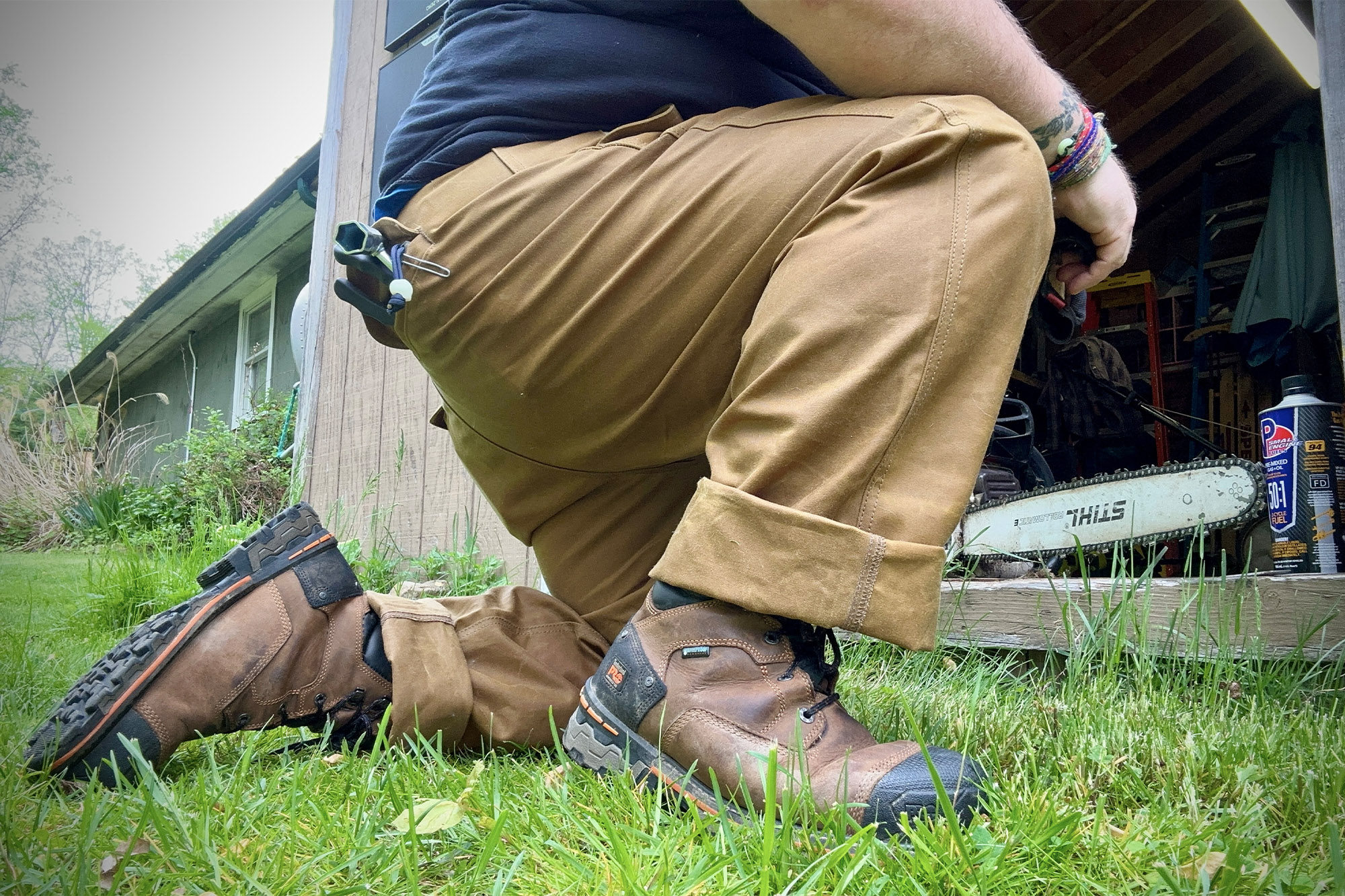
Mixing spandex, or other elastic materials, with cotton or polyester, manufacturers are able to craft pants that withstand the rigors of work, while moving with you as you bop around the job site. We find the mobility of work pants to be one of the most important elements we look for. If we feel constricted while bending down, crouching, or climbing a ladder, it limits our efficiency and is just downright uncomfortable.
All of the work pants on this list were found to be comfortable and not restricting. Even pants like the Filson Oil Finish Single Tin Cloth Pants, which are made from heavier 14oz, waxed cotton allowed us to move and flex freely. However, the most comfortable — and therefore most mobile — pants on this list were the KÜHL Resistor Jeans and the Bulletprufe Denim 5th Gen Jeans. Even though we often think of denim as being stiff and restricting, the fabric blends used in both those pants were the farthest from that.
Price & Value
Because you’re going to put work pants through the wringer, you want to make sure that the money you’re spending on them is worth it. That being the case, here’s what you should expect from your work pants based on how much they cost.
Budget
The nice thing about work pants is that they’re all generally built to stand up to the abuse you’re going to bestow on them. So, in the budget category, all you may be missing from the pants is advanced material blends or finishing treatments — like wax or DWR.
At $70, the Carhartt Rugged Flex Utility Double Front pants are a bargain. They have stood the test of time on numerous job sites and in a multitude of backyards for years. Compared to their higher-priced counterparts, they are only missing improved flexibility and a waterproof or water-resistant finish.
Mid-Tier
Mid-tier work pants are the pants most of us wear. Or, at the very least, pants in this category have appealing features that we are drawn to but aren’t overly expensive. This translates to not being too upset when we’ve finally beaten them to death.
At $80 and $100, respectively, the BRUNT Workwear Martin Pant and Mountain Khakis Camber 107 Pant fit in this category. They both feature advanced materials designed to be durable without impacting your mobility. They also both have a DWR coating on their fabrics to make them resistant to water. This not only aids in how long you can expect these pants to last, but in keeping their shape and not weighing you down.
Premium
If you can expect 6-12 months from a pair of hard-working mid-tier work pants, then there’s no reason to believe that you can’t double that with a pair of premium ones. However, in some cases, plan on paying for that classification.
Pants like the 1620 Workwear Double Knee Utility Pant 2.0 ($198) and Fjallraven Keb Trousers ($240) feature materials that have been designed to be the most durable and flexible on the market today. Additionally, they have fabric treatments that make them water-resistant. When you combine these aspects, you have pants that you’ll probably hold on to for a lifetime, if not for many years of use and abuse.
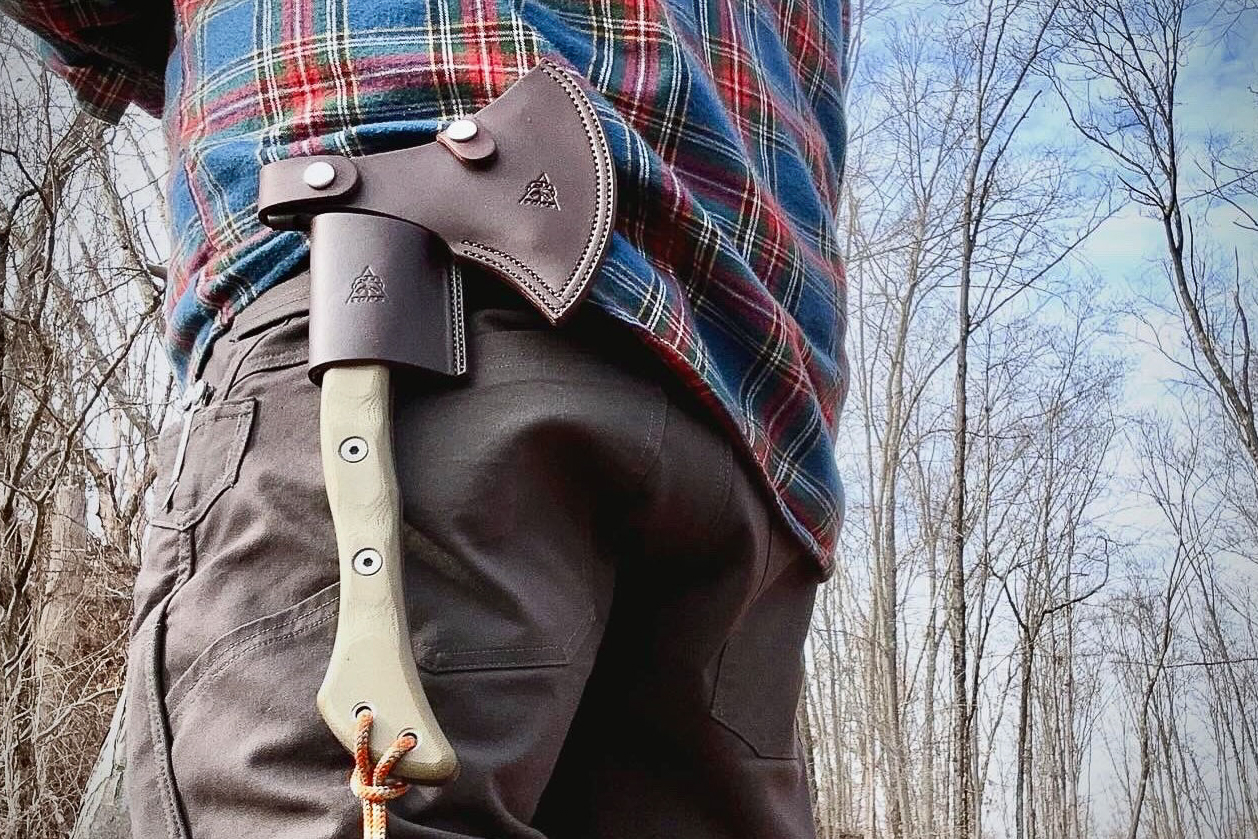
Frequently Asked Questions
Durability is usually a tradeoff with comfort. The softer and more comfortable the pant, the more likely it’s going to be less durable. But it may not matter. If you’re not rubbing or scraping up against rough surfaces, you can get away with a less durable and more comfortable pant.
If you work in a high-abrasion environment, it will be worth getting a stiffer pant that won’t move as easily but will last longer. For a more durable pant, look for a higher denier count, heavier fabric, or brands that use tough fabrics like CORDURA.
Similar to the durability question above, the tradeoff is usually between thinner, more breathable pants that are comfortable in hot weather and thicker, more durable pants. Another factor that can help in hot weather is a looser cut or fit to allow for some air circulation within the pant.
Finally, the material used can play a role. But usually, the more breathable a pant fabric is, the less durable it is. Fjällräven’s Keb Trousers stand in contrast to this, boasting incredible ventilation despite featuring thick, resilient materials. Zippered vents allow you to wear these in hot environments without sacrificing durability.
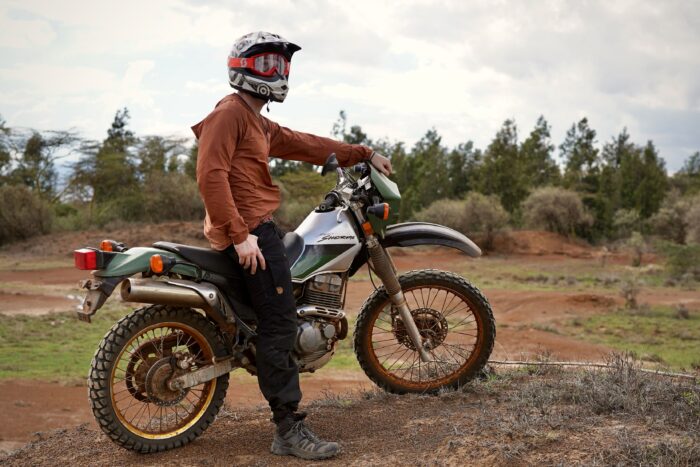
Most clothing is expected to last about 30-40 wash cycles, but our experience has shown that work pants last longer than that. The biggest factor is how the pants are used. If you’re going to a job site and bending and squatting all day or hauling cinder blocks every day for work, the pants are going to wear out much faster than occasional DIY projects at home.
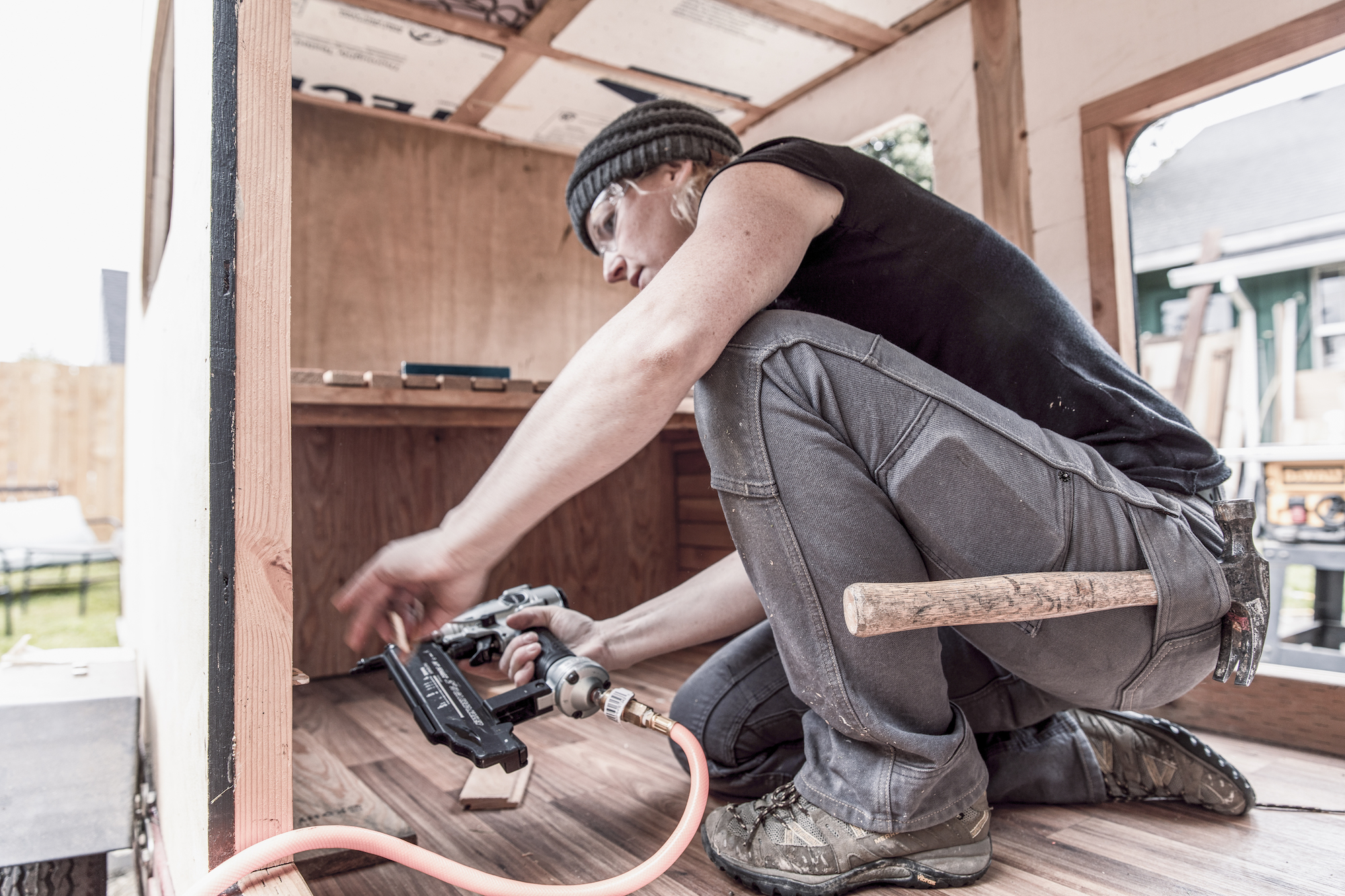
The Best Work Pants for Women
For women with tough and demanding gigs, here are the best work pants that hold up. We tested top picks from Carhartt, Dovetail, and more.

The Best Work Boots of 2025
Protect your feet with one of our picks for the best work boots, including boots from Caterpillar, Danner, and more!

